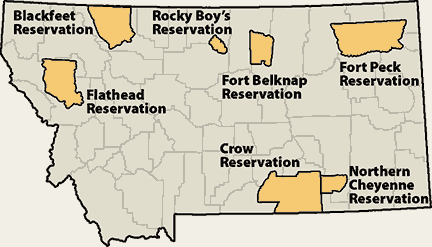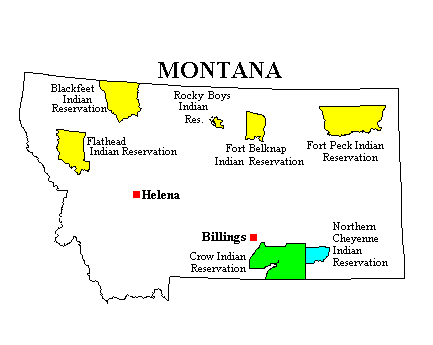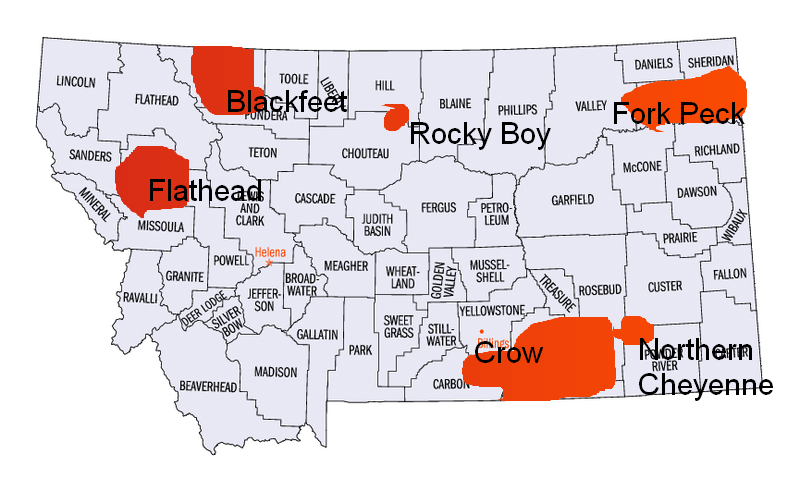indian reservations in montana and wyomingTitle
Land of the Free, Home of the Brave… and the Reservation?

The American West, a land of sweeping landscapes, rugged mountains, and a history etched in both grandeur and hardship. We all know the stories: cowboys, gold rushes, and the westward expansion. But what about the stories of the people who were already here, the indigenous tribes who called this land home long before the arrival of European settlers? Today, we’re venturing into the heart of Montana and Wyoming, exploring the rich tapestry of life on the Indian reservations that dot these states.
A Land of Contrasts
Related Articles: indian reservations in montana and wyomingTitle
- Uncover the Enigmatic World of Native Reservations in Colorado: A Journey of Discovery
- Uncover the Native American Tapestry: Discover the Number of Reservations in Texas
- Unveiling the Secrets: Discoveries Await in South Dakota's Vast Indian Reservation
- Unveil the Enchanting World of Indian Reservations near Tulsa, Oklahoma
- Unveiling the Native Legacy: Discover the Indian Reservations of Massachusetts
Picture this: rolling plains dotted with bison, the majestic peaks of the Rockies casting long shadows, and the steady flow of rivers that have witnessed centuries of history. This is the backdrop for the nine federally recognized tribes in Montana and Wyoming. Each reservation, a unique microcosm of culture, history, and resilience, holds a fascinating story waiting to be discovered.
Montana: Where the Mountains Meet the Plains
Montana, the "Treasure State," is home to five vibrant Indian reservations:
- The Blackfeet Nation: Nestled in the foothills of Glacier National Park, the Blackfeet Reservation is a place where tradition thrives. The Blackfeet people, renowned for their prowess as horsemen and skilled artisans, have a rich cultural heritage deeply rooted in the land.
- The Crow Nation: Known for their fierce independence and vibrant cultural traditions, the Crow Tribe has a long history in the Big Horn Mountains. Their reservation, a vast expanse of rugged beauty, is a testament to their resilience and connection to the land.
- The Flathead Nation: Located in the heart of Montana’s scenic Mission Valley, the Flathead Reservation is a place of peace and beauty. The Salish, Kootenai, and Pend d’Oreille tribes, united by their shared history and cultural heritage, have built a vibrant community where tradition and progress intertwine.
- The Fort Belknap Indian Community: The Assiniboine and Gros Ventre tribes call the Fort Belknap Reservation home. This small but vibrant community boasts a rich cultural heritage, with traditional ceremonies and dances that keep their ancestors’ legacy alive.
- The Northern Cheyenne Tribe: The Northern Cheyenne Reservation, a rugged and beautiful expanse in southeastern Montana, is a place where the spirit of the Cheyenne people runs strong. Their history is one of resilience, adaptation, and a deep connection to their ancestral lands.

Wyoming: Where the Wind Whispers Stories
In Wyoming, the land of wide-open spaces and towering mountains, four tribes call this rugged state home:
- The Wind River Reservation: The Eastern Shoshone and Northern Arapaho tribes share this vast reservation, a haven of cultural diversity and tradition. The Wind River Reservation is a place where ancient stories are whispered on the wind, and the spirit of the ancestors remains strong.
- The Fort Washakie Reservation: The Shoshone Tribe, known for their connection to the land and their resilience in the face of adversity, calls the Fort Washakie Reservation home. This reservation, nestled in the heart of the Wind River Mountains, is a place of breathtaking beauty and deep cultural significance.
- The Eastern Shoshone Reservation: This small reservation, located in the heart of Wyoming’s Wind River Basin, is a testament to the resilience and spirit of the Eastern Shoshone people. They have faced many challenges throughout their history, but their connection to their ancestral lands remains strong.
- The Arapaho Tribe: The Arapaho Tribe, known for their vibrant cultural traditions and their strong connection to the land, has a long history in Wyoming. Their reservation, a place of rugged beauty and rich cultural heritage, is a testament to their resilience and adaptability.


Beyond the Reservations: A Tapestry of Culture and Heritage
While each reservation is a world unto itself, the tribes of Montana and Wyoming also have a strong presence in the larger communities. From powwows and cultural events to museums and art galleries, the vibrant culture of these tribes is woven into the fabric of the state.
Challenges and Triumphs
The story of Indian reservations in Montana and Wyoming is not one of simple triumph. Generations of hardship, from forced relocation and broken treaties to poverty and limited economic opportunities, have left their mark. But amidst the challenges, a spirit of resilience and determination shines through.
Today, tribes are working to build a brighter future for their people. They are pursuing economic development, promoting self-sufficiency, and preserving their cultural heritage. From education initiatives to tourism and business ventures, they are forging new paths while honoring their traditions.
A Call to Understanding
Visiting an Indian reservation is an opportunity to step outside of your comfort zone and immerse yourself in a different world. It’s a chance to learn about history, culture, and the resilience of a people who have faced countless challenges. It’s also a chance to break down stereotypes and misconceptions and build bridges of understanding.
Respect and Responsibility
When visiting a reservation, remember that you are a guest. Show respect for the land, the people, and their traditions. Be mindful of your language and actions, and avoid taking photos or videos without permission. Remember, you are not just a tourist, but a visitor to a living, breathing community.
Beyond the Stereotypes
The story of Indian reservations is not one of poverty and despair. It’s a story of resilience, adaptation, and cultural richness. It’s a story of people who are proud of their heritage, determined to build a better future, and eager to share their culture with the world.
The Future is Bright
The future of Indian reservations in Montana and Wyoming is full of possibilities. With strong leadership, a commitment to education and economic development, and a deep connection to their cultural heritage, these tribes are poised to create a brighter future for their people.
FAQs about Indian Reservations in Montana and Wyoming
1. What are the main cultural differences between the tribes in Montana and Wyoming?
The tribes in Montana and Wyoming each have their unique cultural traditions, languages, and ceremonies. Some common elements include storytelling, dance, music, and traditional arts and crafts. However, each tribe has its own unique perspective and interpretation of these elements.
2. Are there any specific rules or guidelines for visiting Indian reservations?
It’s always best to check with the specific tribe or reservation you plan to visit for their rules and guidelines. Generally, it’s important to show respect for the land, the people, and their traditions. This includes being mindful of your language and actions, and avoiding taking photos or videos without permission.
3. What are some of the economic opportunities available on Indian reservations?
Indian reservations are working to create new economic opportunities for their people. These include tourism, gaming, agriculture, and natural resource management. Many tribes are also developing their own businesses and enterprises.
4. How can I learn more about the history and culture of the tribes in Montana and Wyoming?
There are many resources available to learn more about the history and culture of the tribes in Montana and Wyoming. These include museums, historical sites, tribal websites, and books. You can also attend powwows and cultural events to experience the vibrant traditions of these tribes firsthand.
5. How can I support the tribes in Montana and Wyoming?
There are many ways to support the tribes in Montana and Wyoming. You can visit their reservations, purchase their art and crafts, support their businesses, and advocate for their rights and interests. You can also donate to tribal organizations and charities that are working to improve the lives of their people.
6. Are there any specific places to visit on Indian reservations in Montana and Wyoming?
Each reservation offers unique attractions and experiences. Some popular destinations include Glacier National Park (Blackfeet Nation), Little Bighorn Battlefield National Monument (Crow Nation), and the Wind River Indian Reservation (Eastern Shoshone and Northern Arapaho Tribes).
7. How can I get involved in tribal activities and events?
Many tribes hold powwows, cultural festivals, and other events throughout the year. You can check tribal websites and local newspapers for information about upcoming events. You can also contact tribal tourism offices for more information.
8. What are some of the challenges facing Indian reservations today?
Indian reservations face a number of challenges, including poverty, unemployment, lack of access to healthcare, and limited educational opportunities. However, tribes are working to overcome these challenges through economic development, education initiatives, and community outreach programs.
9. What is the role of the federal government in the lives of Indian tribes?
The federal government has a trust responsibility to Indian tribes, as outlined in treaties and other agreements. This responsibility includes providing funding for education, healthcare, housing, and other services. The federal government also works with tribes on issues such as natural resource management, economic development, and self-governance.
10. What is the future of Indian reservations in Montana and Wyoming?
The future of Indian reservations in Montana and Wyoming is bright. With strong leadership, a commitment to education and economic development, and a deep connection to their cultural heritage, these tribes are poised to create a brighter future for their people.
A Final Thought
The story of Indian reservations in Montana and Wyoming is a story of resilience, adaptation, and cultural richness. It’s a story that deserves to be told, understood, and celebrated. By visiting these reservations, learning about their history and culture, and supporting their efforts to build a brighter future, we can all contribute to a more just and equitable society.

Closure
Thus, we hope this article has provided valuable insights into indian reservations in montana and wyomingTitle. We hope you find this article informative and beneficial. See you in our next article!